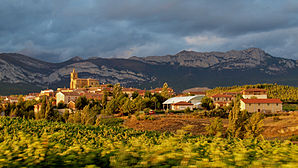Navaridas
| Navaridas | ||
|---|---|---|
 Navaridas - town view
|
||
| coat of arms | Map of Spain | |

|
|
|
| Basic data | ||
| Autonomous Community : |
|
|
| Province : | Álava | |
| Comarca : | Cuadrilla de Laguardia-Rioja Alavesa | |
| Coordinates | 42 ° 33 ′ N , 2 ° 37 ′ W | |
| Height : | 535 msnm | |
| Area : | 8.92 km² | |
| Residents : | 200 (Jan. 1, 2019) | |
| Population density : | 22.42 inhabitants / km² | |
| Postal code : | 01309 | |
| Municipality number ( INE ): | 01041 | |
| administration | ||
| Website : | Navaridas | |
Navaridas is a place and a municipality ( municipio ) with 200 inhabitants (as of January 1, 2019) in the province of Álava in the autonomous community of Basque Country in northern Spain . The place belongs to the Rioja wine-growing region .
location
The place Navaridas is at an altitude of about 535 meters above sea level. d. M. in the south of the province of Álava near the border with the autonomous community of La Rioja . The closest major city is Logroño , about 21 kilometers (driving distance) southeast ; the lovely small town of Laguardia , to which Navaridas belonged until the 17th century, is a good four kilometers to the east.
Population development
| year | 1960 | 1970 | 1981 | 1991 | 2001 | 2011 |
| Residents | 278 | 266 | 180 | 217 | 223 | 223 |
At the end of the 19th century the community had around 350 inhabitants. The phylloxera crisis in viticulture and the mechanization of agriculture with the resulting loss of jobs have led to a continuous decline in the number of inhabitants since then.
economy
In the early centuries, the inhabitants lived mainly on the agricultural products of the surrounding area, which also included wine. The increasing importance of viticulture and wine tourism in the Rioja has had a positive effect on employment again in recent decades.
history
An Iron Age settlement was discovered near the Ermita de Santiago , dating from the 10th to the 5th century BC. Was settled; in contrast, the Celts , Romans , Visigoths and Moors - despite the proximity to the Ebro Valley - left no archaeologically usable traces on the municipality. The place probably first arose in the course of recapturing ( reconquista ) and resettlement ( repoblación ) of the occupied territories from the Moors in the 10th and 11th centuries. Navaridas is first mentioned in 1366; three hundred years later (1666) the Spanish King Charles II granted him independence.
Attractions
- The uncovered remains of the Iron Age settlement on the Alto de Castejón parcel are of little interest to the visitor.
- The parish church ( Iglesia de María Inmaculada ) is a late Gothic building, which, however, underwent some changes in the 16th and 17th centuries - for example, the late Gothic portal was bricked up after the completion of the baroque one. As is customary in the region, both portals are on the south side of the church; the single-nave interior houses a remarkable altarpiece .
- The Palacio de los Sodupe is a three- story building from the 17th century with a stone heraldic shield . The basement contained storage rooms for grain etc .; the two upper floors were used for residential purposes, whereby it can be assumed that only the representative middle floor was used by the manorial family.
- The Ermita de San Juan de Ortega and the Ermita Juradera de Santiago are just outside the village .
Web links
Individual evidence
- ↑ Cifras oficiales de población resultantes de la revisión del Padrón municipal a 1 de enero . Population statistics from the Instituto Nacional de Estadística (population update).
